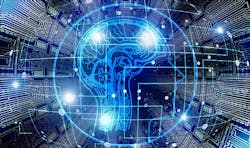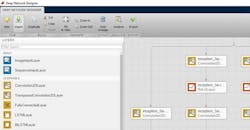MATLAB Deep Learning Toolbox Streamlines AI Development
MathWorks’ MATLAB 2018b release serves up a number of new features, including the Deep Learning Toolbox that supports development of machine-learning applications. Other new features include the 5G Toolbox, NVIDIA Cloud, and DGX support plus Sensor Fusion and Tracking.
The Deep Learning Toolbox supports convolutional neural networks (CNNs) and long short-term memory (LSTM) networks for classification and regression on image, time-series, and text data. It alleviates MATLAB users from having to work with other machine-learning frameworks, although it can also import and export models to frameworks like PyTorch, MXNet, Caffe, and TensorFlow-Keras using the ONNIX, the open neural network exchange format.
Developers can take advantage of MATLAB’s deep-neural-network (DNN) support from MATLAB code (see codelist below). MATLAB Coder or GPU Coder can be used to generate C++ and CUDA code for deployment on Intel using MMKL-DNN, ARM using the ARM Compute Library, and NVIDIA Tegra platforms using NVIDIA’s numerous libraries.
while true
im = snapshot(camera); % Take a picture
image(im); % Show the picture
im = imresize(im,[227 227]); % Resize the picture for alexnet
label = classify(net,im); % Classify the picture
title(char(label)); % Show the class label
drawnow
end
Eight lines of MATLAB code are all that’s needed to take advantage of a classification network to identify images using an AlexNet model.
Coding is just part of the story, though. The Deep Network Designer (see figure) provides a way to use pretrained models including SqueezeNet, Inception-v3, ResNet-101, GoogLeNet, and VGG-19, as well as developing new models. It can be used in conjunction with the MATLAB Image Labeler application, where users can view and label images for semantic segmentation. Developers are able to create domain-specific workflows for ground-truth labeling information for images, videos, and audio clips.
The Deep Network Designer can be used to fine-tune pretrained deep-learning networks.
The toolbox can also be applied to train large datasets by taking advantage of distributed computation via multicore processors and GPUs on the desktop using the Parallel Computing Toolbox. Developers could take advantage of the cloud, too. The Deep Learning Toolbox supports Amazon EC2 P2, P3, and G3 GPU instances using the MATLAB Distributed Computing Server. The toolbox also supports Amazon AWS and Microsoft Azure.
About the Author
William G. Wong
Senior Content Director - Electronic Design and Microwaves & RF
I am Editor of Electronic Design focusing on embedded, software, and systems. As Senior Content Director, I also manage Microwaves & RF and I work with a great team of editors to provide engineers, programmers, developers and technical managers with interesting and useful articles and videos on a regular basis. Check out our free newsletters to see the latest content.
You can send press releases for new products for possible coverage on the website. I am also interested in receiving contributed articles for publishing on our website. Use our template and send to me along with a signed release form.
Check out my blog, AltEmbedded on Electronic Design, as well as his latest articles on this site that are listed below.
You can visit my social media via these links:
- AltEmbedded on Electronic Design
- Bill Wong on Facebook
- @AltEmbedded on Twitter
- Bill Wong on LinkedIn
I earned a Bachelor of Electrical Engineering at the Georgia Institute of Technology and a Masters in Computer Science from Rutgers University. I still do a bit of programming using everything from C and C++ to Rust and Ada/SPARK. I do a bit of PHP programming for Drupal websites. I have posted a few Drupal modules.
I still get a hand on software and electronic hardware. Some of this can be found on our Kit Close-Up video series. You can also see me on many of our TechXchange Talk videos. I am interested in a range of projects from robotics to artificial intelligence.



